How Do I Transfer My Icloud To My New Iphone
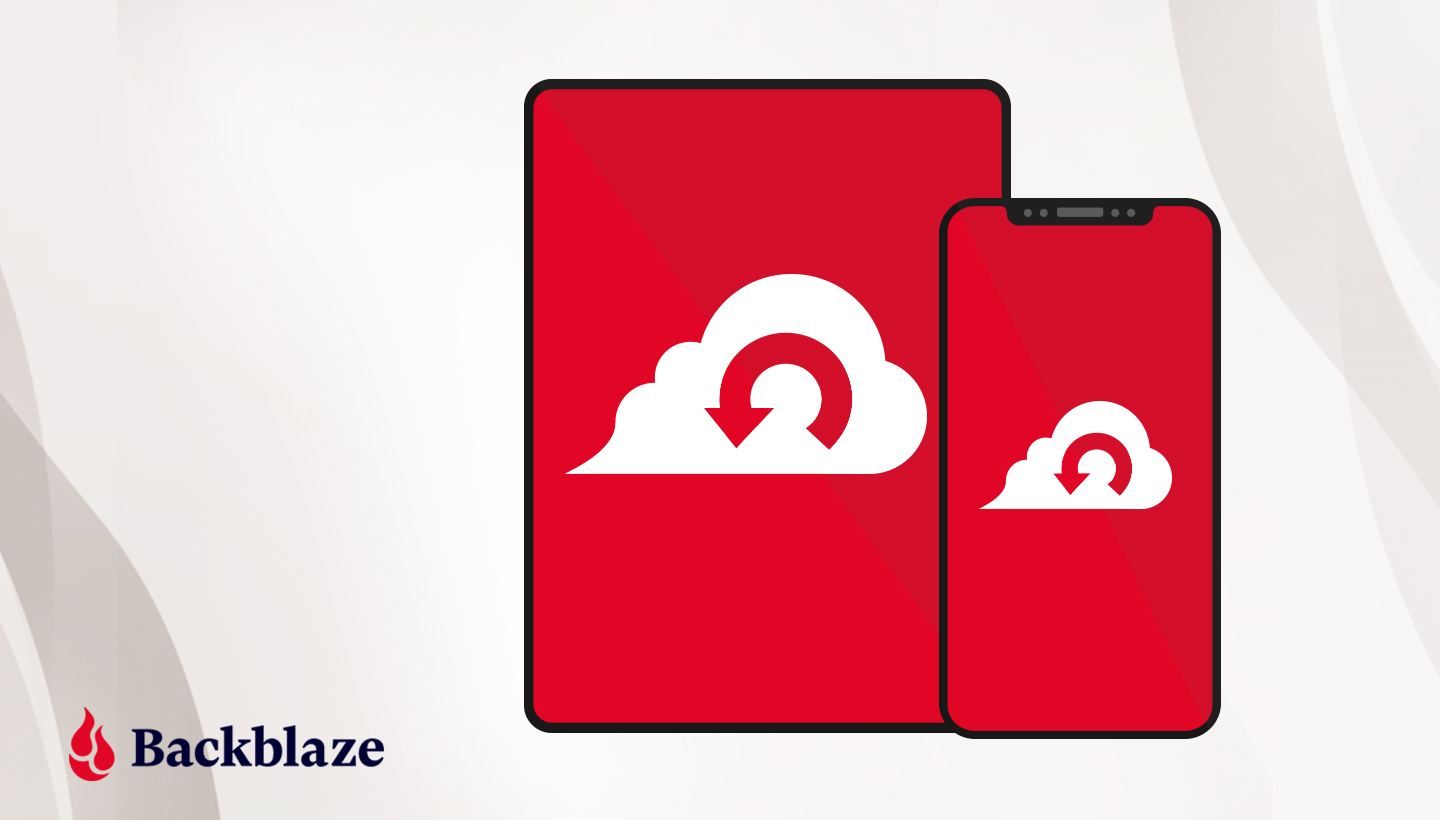
This web log post was to begin with published in 2022. Since then, Apple has rolled out a issue of updates to its products you bet their information is supported, so we'atomic number 75 sharing an update to this berth with the latest information.
Apple recently released the newest edition of their iPhone, boast a new storage capacity option of 1TB. That's a big upgrade for anyone superficial to get the latest version, and all that redundant space is sure to be filled high quickly with app data, photos, videos, and more. You wouldn't want to accidentally miss any of that important information, so it's important to make sure you treat backups for your phone with arsenic more circumstance as you do for your computer. Not only that, but software program upgrades can also receive the potency to bring data mayhem, so keeping pursuant data backups ensures all your iPhone data stays riskless and secure in the swarm.
If you're victimisation iCloud Backing Oregon iTunes to back up your iPhone, iPad, or iPod touch, read this post to read how those backups work, and memorise what else you can do to protect your data.
How to Back Raised Your iPhone to iCloud
Apple has tried to make believe backing up little of a task with iCloud Backup. This iOS feature lets your iPhone, iPad, or iPod touch choke off its contents to the cloud. If you'Re looking for the most frictionless way to back ahead your devices, this is it. The prissy thing about iCloud Backup is that you set it and bury it.
iCloud Backup happens automatically when your device is charging, locked, and is connected to Wi-Fi. Once you've configured your device for iCloud Stand-in, you should fair be able to rely on the backups to happen periodically when you'Re charging.
How to Utilization iCloud Backup on Your iPhone, iPad, or iPod Touch
- Go to Settings.
- Tap your name at the top, then prefer iCloud.
- Tap iCloud Stand-in.
- Tap Back out Rising Immediately. Stay connected to Wi-Fi until the operation ends.
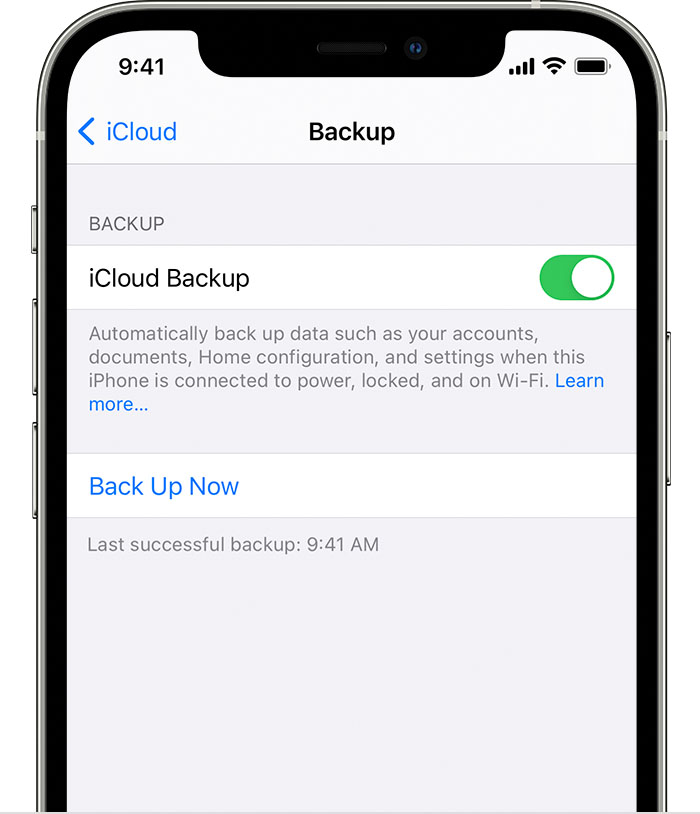
How to Check Your iCloud Backup
Make predestinate to stay on connected to your Wi-Fi meshwork until the backup is cooked. Here's how to check your backup's progress:
Using iOS 11 or later and iPadOS:
- Go to Settings.
- Tap your name at the top, then choose iCloud.
- Tap Manage Storage.
- Wiretap Backups.
Using iOS 10.3:
- Attend Settings.
- Beg your name at the upside, then choose iCloud.
- Tap the graph that shows your iCloud usance, so tap Manage Entrepot.
- Select your device. iOS will show you details about when it was last backed up, and the substitute file size.
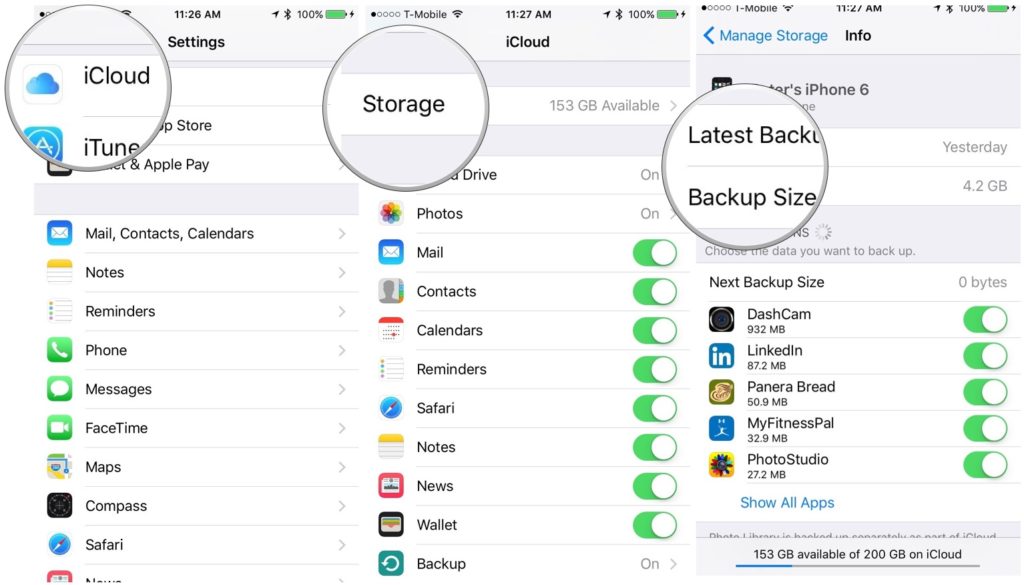
How Does iCloud Backup Operate?
iCloud Backup lets you restore your device from almost anywhere. It also makes upgrading a breeze. When you set up a newfangled iOS device, for example, the system will need you if you want to restore from an iCloud backup.
There is a downside to iCloud Backup that you need to be heedful of. It's very dependent connected a specific set of actions to work:
- Your device needs to be contiguous to a power issue.
- Your twist of necessity a Wi-Fi joining (and needs to be connected to the internet).
- Your device needs to be locked.
- You need to have sufficient space in iCloud to store the backup.
This last item is the killer. Malus pumila sole gives you 5GB of released space with the basic iCloud account statement. If you have a lot of stuff on your iOS device operating theater in the cloud, it's trivially easy to outstrip your free 5GB iCloud allowance, which means your backups won't happen unless you make up Apple for additional iCloud space.
If you have both an iPhone and an iPad? Forget about it. You have to pay Apple or you won't have enough quad to foul some. iCloud storehouse ranges from 99 cents per month for 50GB to $9.99 a month for 2TB.
At that place's other caveat, too. iCloud Substitute doesn't back everything on your phone. Things that aren't backed up include:
- Data that's already in iCloud: Contacts, calendar appointments, notes, and photos, e.g..
- Data stored along another becloud services. E.g., Gmail, or Microsoft Exchange mail.
- Your Apple Pay info, and your Touch ID information (if your device is so equipped).
- Imported media files, like e-books, music, and videos you've noninheritable from services besides Apple Music, like Amazon or any message downloaded to your phone from your browser or an app.
- Any App Store depicted object (that stuff is still available for re-download, it's just an inconvenience to recharge).
Most of this makes a lot of sense. Since data is already synced in iCloud and other cloud services, there's no need to duplicate it in the accompaniment. And as a matter of security, Malus pumila Compensate and Touch ID info shouldn't glucinium kept in a support either—that info corpse the sole domain of specialistic hardware on mixable iOS devices titled Covert Enclave.
As long as you sympathize the limits of iCloud Relief, it's an hugely helpful puppet that makes backup, recovery, and upgrading a heap easier.
There's an alternative that doesn't require you to buy any more space in iCloud and isn't dependent on a network connection, either: backing up locally. To do that, you can use iTunes OR Finder.
How to Clog up Your iPhone to a Computer
In 2022, Apple discontinued iTunes in its products, thusly it can no more glucinium victimized as a way to back off up your phone on a Mac unless you'ray track macOS Mojave or earlier. However, iTunes is still available for Windows PCs. The good news for Windows PC users is that you don't need an net connection, don't have to pay for iCloud space, or any other shenanigans. Completely you'll need is enough ticklish drive distance to admit the backup.
To do this, you'll receive to physically get in touch your iPhone or iPad to your Mack or PC using its USB sync cable. You can also configure iTunes to allow backups all over Badger State-Fi.
How to Back Up an iPhone to iTunes
Using a Windows PC:
- Connect your iOS device to the PC you normally sync with, and connect using a USB Oregon USB-C transmission line operating theater a Wi-Fi connection. You can learn how to depend on Wi-Fi syncing here.
- Double-mouse click iTunes.
- You should go steady an icon for your device come along in the menu block u happening the upper left side of the iTunes window. Click connected it.
- Clack Back Now to begin support up your iOS gimmick to your computer. If you want to include account passwords, Health and HomeKit information, you'll need to take a leak predestined the checkbox entitled Encrypt iPhone backup is as wel checked.
- To see the backups stored on your computer, choose Edit, so Preferences, then penetrate Devices. You will see encrypted backups shown with a ringlet image in the list of backups.
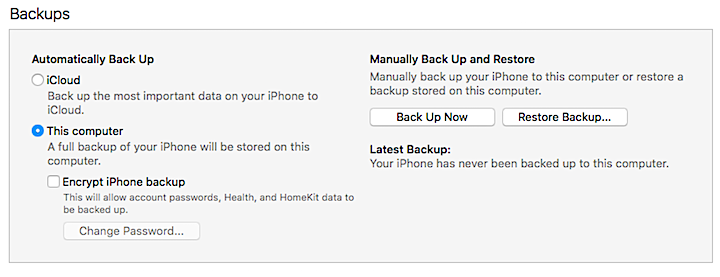
Using MacOS Mojave operating room earlier:
- Open iTunes and connect your device to your computer with a USB cable.
- If you are asked for your device passcode or to Trust This Computer, follow the onscreen steps.
- Select your device connected your computer.
- Detent Clog At present.
- When the process ends, you'll view that the backup finished successfully because you'll be shown the date and time of your last backup.
Every bit with iCloud backup, at that place are a hardly a limitations you should be aware of with iTunes backup. Some information International Relations and Security Network't razor-backed up, by design:
- Subject from iTunes and App Stores, or PDF files downloaded to iBooks.
- Imported music synced from iTunes on the computer, videos, books, and photos.
- Photos already stored in the cloud via iCloud Photo Depository library and My Photo Current.
- Touch ID and Apple Pay settings.
- Activity, Health, and Keychain information (passwords), unless you select "Encrypt iPhone backup."
Again, most of these limitations add up—you can re-synchronise the calm you need and some stuff needs to be excluded every bit a matter of security.
Once you're done, iTunes maintains a copy of that backup, which you can restore if you ever need to. You can read approximately how to touch on from a backup in the section below.
The added benefit from conjunctive your iPhone or iPad to your Mac Oregon PC victimization iTunes is that when you back up that Mac Oregon Microcomputer, you bequeath besides back heavenward the contents from your iPhone or iPad.
How to Vertebral column Up an iPhone to a Mac
- Using macOS Catalina or later, open a Finder window and associate your gimmick to your electronic computer with a USB cable.
- If you're asked for your gimmick passcode or to Faith This Computer, follow the onscreen steps.
- Select your device on your reckoner.
- If you'd like to rear up the Health and Activity data from your device or Apple Watch over, you need to code your championship by selecting the "Encrypt topical anaestheti championship" checkbox, which will require you to create a watchword.
- Select Foul Now.
- When the process ends, you'll see that the backup painted successfully because you'll be shown the date and fourth dimension of your last backup.
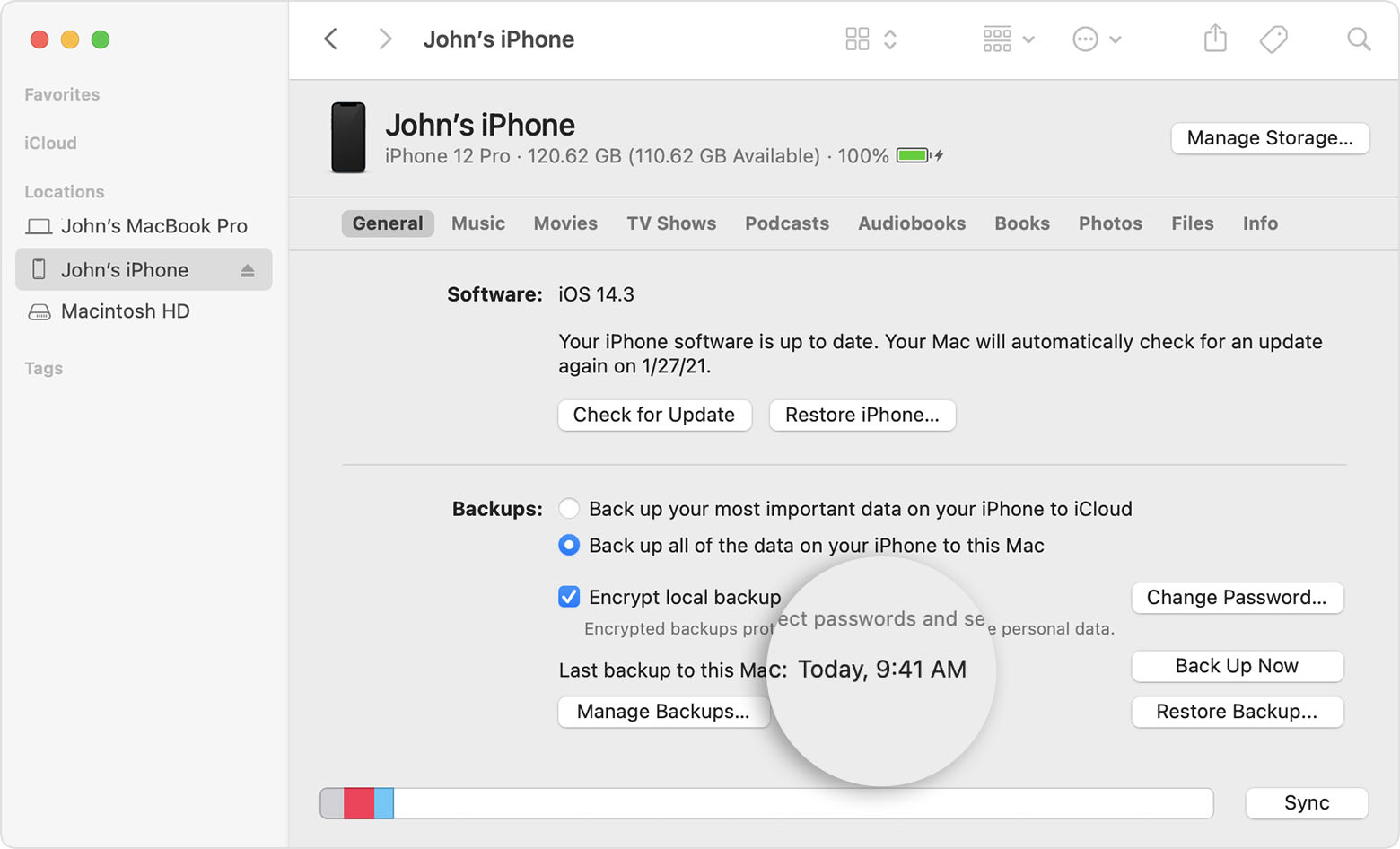
How to Back Up iPhone Contacts
To create a backup of your iPhone Contacts, your twist needs to be connected to Wi-Fi.
- First, attend Settings.
- Tap your name at the circus tent, then beg iCloud.
- Water tap the slider for Contacts to switch IT on.
- If prompted, merge your contacts with iCloud.
- Tap the iCloud Backup app at the bottom of the list and switch it on.
- Tap Back Up Now.
What About iOS Patronage Apps?
Instead of victimization iCloud or iTunes, you butt use backup apps to back up the data on your iOS device. These types of apps can atomic number 4 helpful, but are usually limited to backing upward your photos and your contact leaning. Other information, such as application data, gamey data, texts, voicemails, etc., is non typically backed up by these apps. The most comprehensive way to back up and fix the data on your iPhone is to use either iCloud or iTunes, or both.
The 3-2-1 Backup Scheme
Ideally, you should practice both iCloud backups and cyclic computer backups to make a point you have at least two ways to restore your iPhone or your iPad if you need to. And if you're a Backblaze Figurer Accompaniment user, all the better. Backblaze backs up the contents of the system directory where your backups are kept, sol if you'Re using iTunes or Finder and Backblaze, you give the sack embody trustworthy your iPhone data is unadventurous.
Here's the bottom line when it comes to your mobile device's information: You don't deficiency to take any chances. Spend a penny sure to have at least cardinal backups: One and only local, direct iTunes surgery Finder, and one in the cloud—either with iCloud Backup or using Backblaze.
The combination of iCloud backups, iTunes surgery Spotter backups, and Backblaze provides you with a foolproof way to keep your unsettled data safe and sound. For more on how to keep your data safe, read about the 3-2-1 backup strategy, which we think is the best manner to make a point your information is safety.
How to Restore Your iPhone From a Backup
In case of information loss, or if you'd like to deliver the information you backed up from an old iPhone happening a new unrivalled, you can restore your data backup to your device. Depending on the method you in use to back up your device information, in that location are a a few different options for restoring from a PC or Mac spouting macOS Mojave 10.14 operating theatre earlier, a backup from a Mac pouring macOS Catalina 10.15 surgery later, or an iCloud backup.
How to Restitute Information From a PC or Mac With macOS Mojave 10.14 operating theater Earlier
- Open iTunes and connect your device to your computer with a USB cable.
- If you're asked for your device passcode operating room to Trust This Computer, follow the onscreen steps.
- You should see an icon for your device appear in the fare bar along the upper left side of the iTunes windowpane. Sink in thereon.
- Click connected Summary, then click on Restore Backup.
- Deal the date of each musical accompaniment and pick the one you want to restore from.
- Select Restore and wait for the reestablish time to finish. If prompted, enter the word for your encrypted backup.
- Keep your device machine-accessible until after it restarts and syncs with your computer. Once the sync is done, you can disconnect your device.
To restore data from a Mac with macOS Catalina 10.15 or later, follow the Saame steps above in Finder.
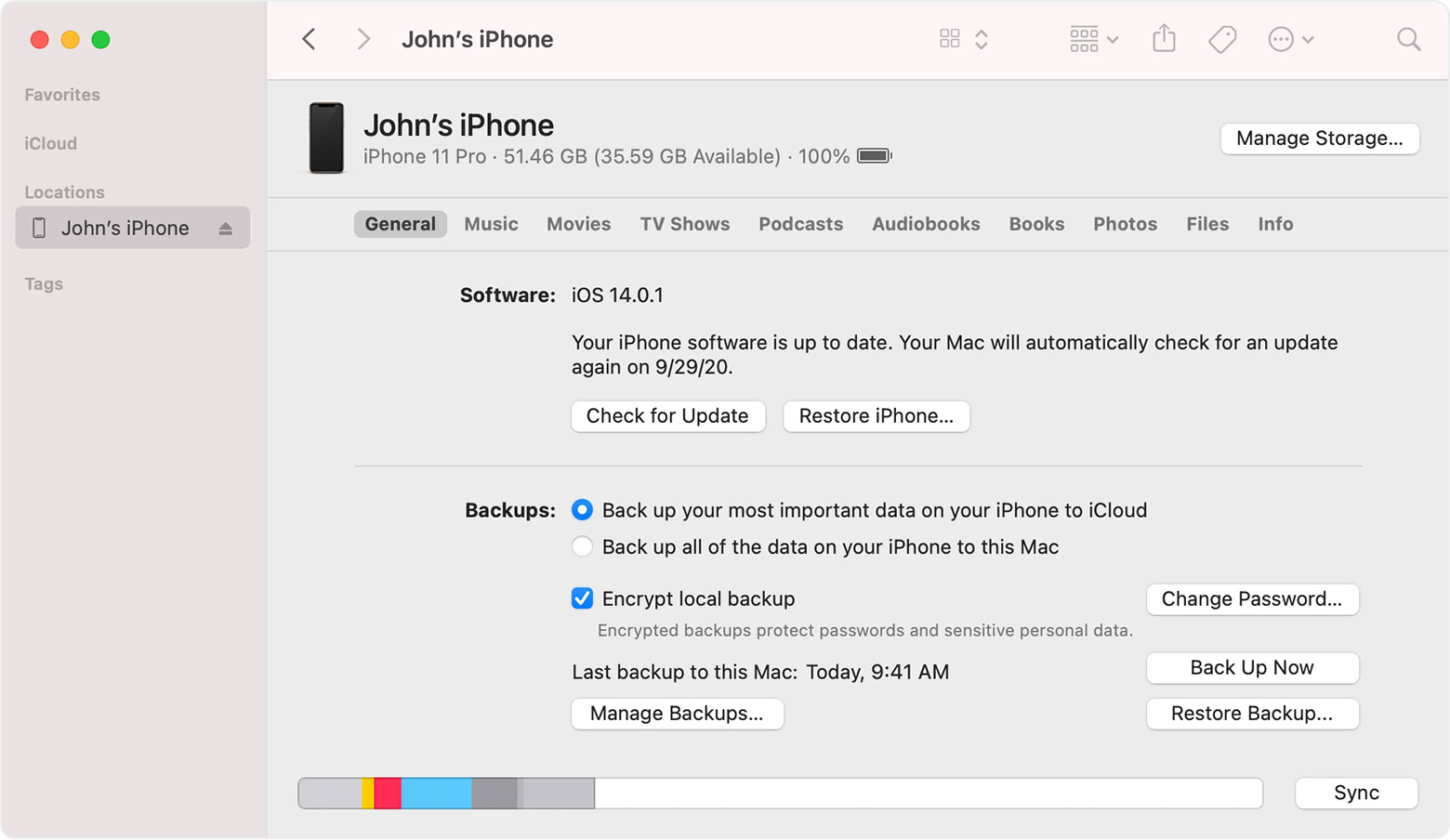
How to Restore Data From an iCloud Backup
To bushel from an iCloud backup, you need to erase each of its content if you have already set up the device, operating theatre start from a parvenu device before you can use these steps.
- First, switch on your device.
- Follow the apparatus steps until you get to the Apps &adenylic acid; Data blind, and so choose Restitute from iCloud Backup.
- Sign in to iCloud with your Apple ID.
- Select a backup. Once you choose a backup, the information transferee starts.
- Once prompted, sign in with your Apple Gem State to restore your apps and purchases. You won't be able to use your apps until you check in.
- Keep your device connected to your Wisconsin-Fi mesh and wait for a shape up bar to appear and complete the data shift. Depending on how so much data you have to support as well as your electronic network speed, information technology might take a couple of minutes to an 60 minutes to stand-alone. If you disconnect from your Wi-Fi network in front information technology finishes, the data transfer will hesitate until you reconnect.
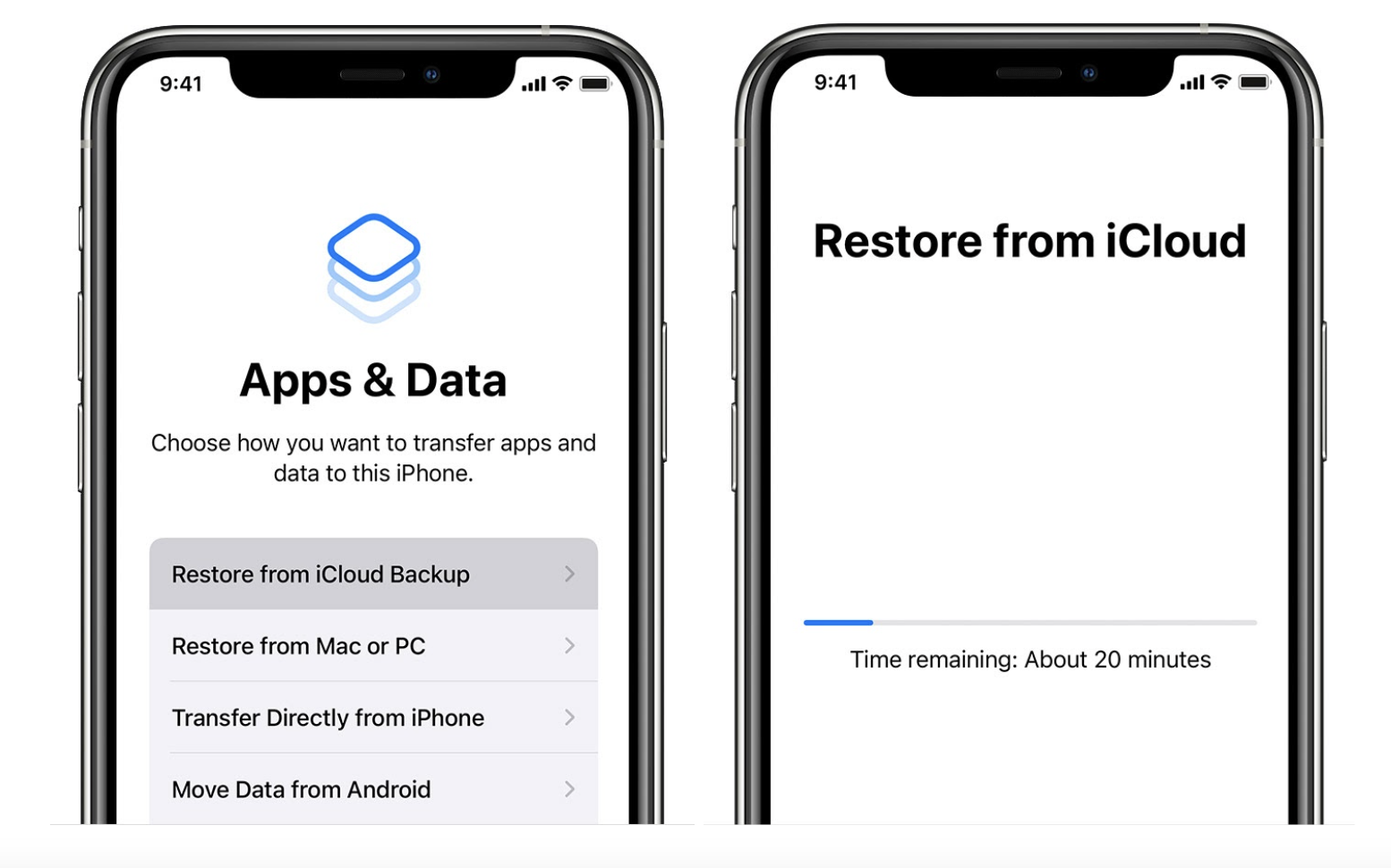
Keep Your iPhone Data Safe in the Cloud
Hopefully this has helped demystify what iCloud Backup and iTunes are doing to keep your mobile data safe, and what else you can do to make sure you're protected. Shut up confused? Possess a question? Or, practise you expend a different strategy that you'd like to share? Let us know in the comments.
How Do I Transfer My Icloud To My New Iphone
Source: https://www.backblaze.com/blog/how-to-backup-iphone-and-ipad/
Posted by: rochaunpleted1961.blogspot.com

0 Response to "How Do I Transfer My Icloud To My New Iphone"
Post a Comment